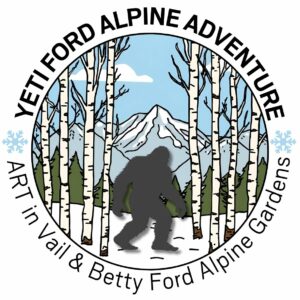

Yeti Ford: Alpine Adventure is a spectacular, community-focused winter art exhibit hosted by Betty Ford Alpine Gardens, featuring larger than life yeti sculptures transformed into unique masterpieces by local schoolchildren. This exhibit is an exciting collaboration between the Gardens, Town of Vail’s Art in Public Places, and multiple local schools, designed to provide students with the invaluable experience of creating large-scale public art. See the Yetis daily from dawn to dusk through March, and celebrate the exceptional talent within the Vail community.


Habitats provide homes for all living things, from the tiniest ant to the tallest tree. The exhibition Habitat explores the critical need for varied habitats, how interconnected and fragile they are, and what we can do to protect them. The experience showcases the unique habitats throughout Betty Ford Alpine Gardens. Habitat was developed by Smithsonian Gardens and is made available by the Smithsonian Institution Traveling Exhibition Service.
The Bug B&B exhibit, located in our vibrant pollinator garden, invites visitors to discover the vital role insects play in supporting healthy ecosystems. This Garden provides food and shelter for beneficial insects like bees, butterflies, and beetles, all of which are essential for pollination and plant health. Learn more about how pollinator-friendly gardens help support biodiversity and sustain the delicate balance of life. Visitors are encouraged to take inspiration from this exhibit and create welcoming spaces for pollinators in their own backyards!
“Key to the Montane” explores the transformative impact of beavers in mountainous ecosystems. As keystone species, beavers engineer their environment by building dams that create wetlands, which in turn support diverse plant and animal life. These wetlands improve water quality, mitigate floods, and provide habitats for countless species. This section highlights the beaver’s crucial role in maintaining ecological balance and the importance of conserving their habitats.
In the “Nests” section of the exhibit, visitors can marvel at replicas of bird nests created by local students! Learn more about the diversity and ingenuity of avian architecture. From the intricate weaving of a hummingbird’s nest to the sturdy construction of a hawk’s abode, these structures provide shelter, protection, and breeding grounds for birds. The exhibit underscores the significance of preserving natural habitats that support bird populations and the ecosystems they inhabit.
The “Homes” exhibit demonstrates how our personal gardens can serve as vital habitats for wildlife. By incorporating native plants, providing water sources, and creating shelter, gardeners can attract pollinators, birds, and beneficial insects. See what our gift shop has for sale that can transform outdoor spaces into thriving ecosystems, contributing to biodiversity and environmental health right at home.
“Dead Wood Is Life” challenges the perception of fallen trees as mere debris, revealing their essential role in forest ecosystems. Decomposing wood provides habitat for fungi, insects, birds, and mammals, while enriching the soil with nutrients. This exhibit, located in our Stumpery Garden, showcases the life-giving properties of dead wood and emphasizes the importance of leaving fallen trees in natural areas.
Enter the “Back to Nature” area of the Gardens to delve into the fascinating world of fungi and their indispensable functions in nature. Fungi decompose organic matter, recycle nutrients, and form symbiotic relationships with plants, aiding in nutrient absorption. Through mycelial networks, mushrooms facilitate communication between plants, enhancing ecosystem resilience. This section highlights the critical contributions of fungi to soil health, plant growth, and overall ecological balance.